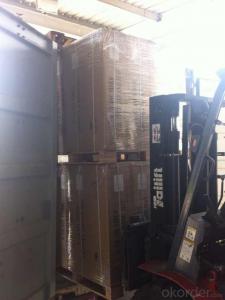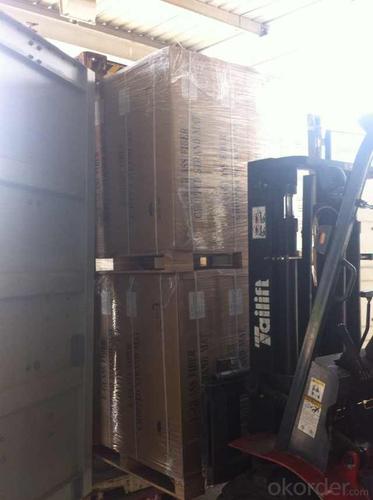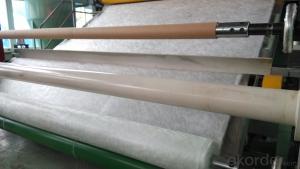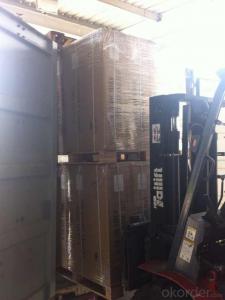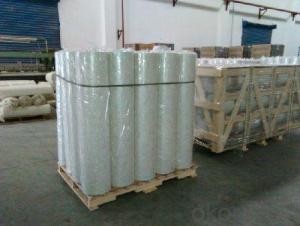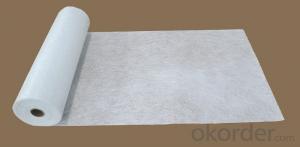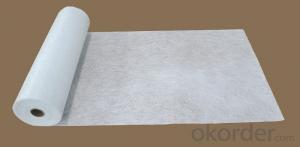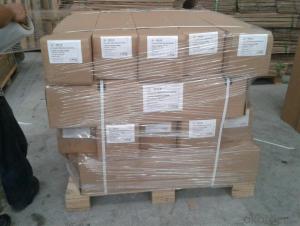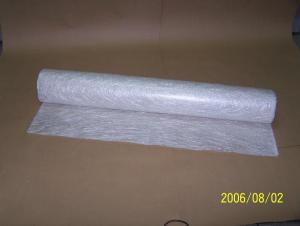Fiberglass Mat Tissue - Chopped Strand Mat (E Glass Fiber)
- Loading Port:
- Shanghai
- Payment Terms:
- TT or LC
- Min Order Qty:
- 20000 kg
- Supply Capability:
- 200000Kg Per Month kg/month
OKorder Service Pledge
OKorder Financial Service
You Might Also Like
1.Briet Introductions
Fiberglass Chopped Strand Mat is made of randomly distributed chopped strands held tighter by a emulsion binder. It is compatible with UP, VE, EP resins.
It is compatible with UP, VE, EP, PF resins.
The roll width ranges from 50mm to 3300mm.
Additional demands on wet-out and decomposition time may be available upon request.
It is designed for use in hand lay-up, filament winding, compression molding and continuous laminating processes. Its end-use applications include boats, bath equipment, automotive parts, chemical corrosion resistant pipes, tanks, cooling towers and building components.
2.Product Features
Fast breakdown in styrene
High tensile strength, allowing for use in hand lay-up process to produce large-area parts
Good wet-through and fast wet-out in resins, rapid air lease
Superior acid corrosion resistance
3.Product Specifications
Property | Area Weight | Moisture Content | Size Content | Breakage Strength | Width |
(%) | (%) | (%) | (N) | (mm) | |
Mathods | IS03374 | ISO3344 | ISO1887 | ISO3342 | |
EMC80E | ±7.5 | ≤0.20 | 8-12 | ≥40 | 50-3300 |
EMC100E | ≥40 | ||||
EMC120E | ≥50 | ||||
EMC150E | 4-8 | ≥50 | |||
EMC180E | ≥60 | ||||
EMC200E | ≥60 | ||||
EMC225E | ≥60 | ||||
EMC300E | 3-4 | ≥90 | |||
EMC450E | ≥120 | ||||
EMC600E | ≥150 | ||||
EMC900E | ≥200 |
Special specification can be produce according to customer requirements.
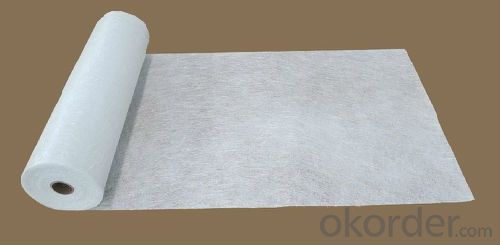
4.FAQ
Packaging:
Each Chopped Strand Mat is wound onto a paper tube which has an inside diameter of 76mm and the mat roll has a diameter of 275mm. The mat roll is wrapped up with plastic film,and then packed in a cardboard box or wrapped up with kraft paper. The rolls can be vertically or horizontally placed. For transportation, the rolls can be loaded into a cantainer directly or on pallets.
Storage:
Unless otherwise specified, Chopped Strand Mat should be stored in a dry, cool and rain-proof area. It is recommended that the room temperature and humidity should be always maintained at 15℃~35℃ and 35%~65% respectively.
- Q: How does the weight of fiberglass mat tissue affect its performance?
- The weight of fiberglass mat tissue significantly affects its performance. The weight of the tissue refers to the amount of glass fibers per unit area. Generally, a higher weight indicates a higher concentration of fibers, which leads to improved strength and durability. Firstly, a heavier fiberglass mat tissue provides better tensile strength. The increased number of fibers in the tissue allows it to withstand higher levels of stress and strain without breaking or tearing. This makes it ideal for applications that require high load-bearing capacity, such as structural components in construction or automotive industries. Moreover, the weight of the tissue also influences its stiffness and rigidity. A heavier mat tissue offers better dimensional stability, meaning it will retain its shape and form even when subjected to external forces. This is crucial in applications where the material needs to maintain its structural integrity, such as in boat hulls or wind turbine blades. Furthermore, the weight of the fiberglass mat tissue affects its thermal and acoustic insulation properties. A higher weight typically correlates with better insulation capabilities, as the increased fiber density enhances the material's ability to trap air and reduce heat transfer or sound transmission. This makes it suitable for applications that require effective insulation, such as in buildings or industrial equipment. Lastly, the weight of the fiberglass mat tissue can impact its ease of handling and installation. A lighter tissue may be more flexible and easier to manipulate, making it simpler to fit into complex shapes or tight spaces. On the other hand, a heavier tissue might require additional support or equipment during installation. In conclusion, the weight of fiberglass mat tissue directly influences its performance characteristics, including tensile strength, rigidity, insulation properties, and ease of handling. Therefore, it is essential to consider the intended application and the desired performance requirements when selecting the appropriate weight of fiberglass mat tissue.
- Q: Can fiberglass mat tissue be used for insulation boards?
- Yes, fiberglass mat tissue can be used for insulation boards. It is frequently utilized in insulation boards due to its excellent thermal and acoustic insulation properties. The fiberglass mat tissue helps to enhance the insulation capabilities of the boards, making them more energy-efficient and effective in reducing heat transfer and sound transmission.
- Q: What is the fire rating of fiberglass mat tissue?
- The fire rating of fiberglass mat tissue can vary depending on its specific composition and intended application. However, fiberglass mat tissue typically has a good fire resistance rating due to the inherent properties of fiberglass, such as its high melting point and non-combustible nature. It is often used in fire-rated applications where fire protection is required.
- Q: Can fiberglass mat tissue be used for insulation purposes?
- Indeed, insulation purposes can be achieved using fiberglass mat tissue. This lightweight material is crafted from delicate glass fibers that are skillfully bonded together with a binder. Although it is commonly utilized as a reinforcement material within the construction industry, it also serves as a valuable source of insulation. The thermal insulation properties of fiberglass mat tissue are truly outstanding, rendering it a highly effective option for insulating various structures, including buildings. By impeding heat transfer, it ensures that the interior of a building remains warm during chilly weather and cool during hot spells. Furthermore, its non-combustible nature guarantees a secure choice for insulation purposes. The popularity of fiberglass mat tissue as an insulation material stems from its flexibility and effortless installation. It can be easily cut and molded to fit diverse spaces, making it an adaptable choice for a multitude of construction projects. Additionally, its resistance to moisture, mold, and mildew ensures that its insulation performance remains durable and long-lasting. To summarize, fiberglass mat tissue is indeed a viable option for insulation purposes. Its remarkable thermal insulation properties, non-combustible characteristics, and ease of installation make it an ideal choice for enhancing energy efficiency and insulating buildings.
- Q: What is the expected lifespan of fiberglass mat tissue in chemical storage applications?
- The lifespan of fiberglass mat tissue in chemical storage applications can vary depending on several factors. These factors include the type and concentration of chemicals being stored, as well as the specific conditions of the storage environment. Fiberglass mat tissue is widely used in chemical storage applications because it has excellent corrosion resistance and provides structural reinforcement. However, it is important to note that fiberglass mat tissue is not completely immune to chemical degradation. In general, fiberglass mat tissue can withstand a wide range of chemicals and has a relatively long lifespan when properly maintained. It is typically designed to last for several years, and some manufacturers offer warranties ranging from 10 to 20 years. However, aggressive chemicals or extreme storage conditions can accelerate the degradation of fiberglass mat tissue. Chemicals with high acidity or alkalinity, extreme temperatures, or prolonged exposure to UV radiation can potentially reduce the lifespan of the material. To ensure the maximum lifespan of fiberglass mat tissue in chemical storage applications, it is crucial to carefully select the appropriate type of fiberglass mat tissue that is specifically designed for the intended chemicals and storage conditions. Regular inspections, maintenance, and proper handling of the chemicals can also help prolong the lifespan of the material. Ultimately, it is advisable to consult with the manufacturer or a qualified engineer to determine the expected lifespan of fiberglass mat tissue in a specific chemical storage application. They can provide more accurate information based on the specific circumstances.
- Q: How does the surface finish of fiberglass mat tissue affect its adhesion to resin?
- The surface finish of fiberglass mat tissue can significantly affect its adhesion to resin. The surface finish refers to the texture or smoothness of the fiberglass mat tissue. In general, a rougher surface finish tends to provide better adhesion to resin. This is because a rough surface provides more surface area for the resin to adhere to, allowing for a stronger bond. Rougher surface finishes can be achieved through various manufacturing techniques, such as using coarser fibers or adding texturizing agents during production. On the other hand, a smoother surface finish may result in weaker adhesion. A smooth surface does not provide as much surface area for the resin to bond with, leading to a weaker and less durable bond. Smoother surface finishes can be achieved by using finer fibers or through additional processing steps to smooth out the surface. It is important to consider the specific application and requirements when choosing the surface finish of fiberglass mat tissue. For applications that require high strength and durability, a rougher surface finish may be preferred to ensure optimal adhesion to the resin. Conversely, for applications where a weaker bond is acceptable or where a smoother surface finish is desired for aesthetic reasons, a smoother surface finish may be chosen. Ultimately, the surface finish of fiberglass mat tissue plays a critical role in determining the adhesion to resin. It is essential to select the appropriate surface finish to achieve the desired strength, durability, and performance in various applications.
- Q: What is the expected lifespan of fiberglass mat tissue in outdoor applications?
- The durability of fiberglass mat tissue when used outdoors can be influenced by a variety of factors, including exposure to weather conditions, maintenance efforts, and material quality. On average, fiberglass mat tissue is designed to last approximately 20 to 30 years in outdoor applications. Fiberglass mat tissue finds widespread usage in outdoor industries such as roofing, construction, and automotive, where it provides reinforcement and strength to surfaces. Its notable characteristics include durability, moisture resistance, and the ability to withstand harsh weather conditions. To ensure an extended lifespan for fiberglass mat tissue in outdoor applications, proper maintenance and protection are vital. Regular inspections, cleaning, and timely repairs can help prevent potential damage and deterioration. Furthermore, the application of protective coatings or sealants can enhance its resistance to UV rays, moisture, and other environmental factors. It is worth mentioning that the lifespan of fiberglass mat tissue may differ based on the specific application and the quality of the material employed. Therefore, it is advisable to consult the manufacturer or an industry professional to determine the expected lifespan for a particular project or application.
- Q: Is fiberglass mat tissue suitable for construction applications?
- Yes, fiberglass mat tissue is suitable for construction applications. Fiberglass mat tissue is a versatile material that is commonly used in construction due to its strength, durability, and resistance to various environmental factors. It is often used in applications such as roofing, flooring, insulation, and wall panels. Fiberglass mat tissue is an excellent choice for construction projects because it provides reinforcement and stability to various materials. It adds strength to roofing materials, making them more resistant to impact, weathering, and fire. Similarly, it enhances the strength and durability of flooring systems, making them capable of withstanding heavy loads and foot traffic. Additionally, fiberglass mat tissue is an effective insulation material. It can be used to insulate walls, ceilings, and floors, helping to maintain a comfortable indoor temperature while reducing energy consumption. Its thermal and acoustic insulation properties make it an ideal choice for construction applications. Moreover, fiberglass mat tissue is resistant to moisture, chemicals, and corrosion, which makes it suitable for use in areas with high humidity or exposure to harsh chemicals. It does not rot or decay, making it a long-lasting option for construction projects. In conclusion, fiberglass mat tissue is well-suited for construction applications due to its strength, durability, insulation properties, and resistance to various environmental factors. Its versatility and reliability make it a popular choice in the construction industry.
- Q: How does fiberglass mat tissue compare to fiberglass insulation batts?
- Fiberglass mat tissue and fiberglass insulation batts serve different purposes and have distinct characteristics. Fiberglass mat tissue is primarily used as a reinforcement material in various applications such as roofing, wall coverings, and composite materials. It provides strength, durability, and improved dimensional stability to the finished product. On the other hand, fiberglass insulation batts are specifically designed for thermal insulation purposes, typically used in walls, ceilings, and attics to prevent heat transfer. They are engineered to trap air pockets within the material, providing excellent thermal resistance. While both products are made from fiberglass and offer certain insulation properties, their specific applications and performance differ significantly.
- Q: Can fiberglass mat tissue be used for insulation in research laboratories?
- Indeed, insulation in research laboratories can utilize fiberglass mat tissue. This material, widely employed for thermal and acoustic insulation, boasts exceptional insulating qualities. Its resistance to heat, moisture, and chemicals renders it ideal for laboratory environments. Moreover, fiberglass mat tissue's lightweight nature and effortless installation enable swift and efficient insulation in research laboratories. Its low thermal conductivity further aids in maintaining stable temperature conditions, guaranteeing optimal experiment conditions while curbing energy consumption. In conclusion, fiberglass mat tissue presents itself as a practical option for insulating research laboratories.
Send your message to us
Fiberglass Mat Tissue - Chopped Strand Mat (E Glass Fiber)
- Loading Port:
- Shanghai
- Payment Terms:
- TT or LC
- Min Order Qty:
- 20000 kg
- Supply Capability:
- 200000Kg Per Month kg/month
OKorder Service Pledge
OKorder Financial Service
Similar products
Hot products
Hot Searches
Related keywords
